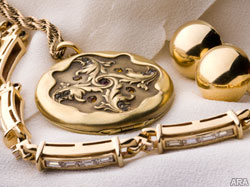(ARA) – Has your jewelry box become a treasure chest? People collect silver, gold, platinum, and other precious metals for several reasons. For many, a jewelry collection of any kind has enormous sentimental value, having been passed down from generation to generation, with pieces symbolizing milestones in life. Others collect jewelry and coins as an investment, one that is much less volatile than stocks.
No matter why you possess these metals, your passion (or investment) has recently reached a peak in value. This increase in value is a trend that is expected to continue across several precious metal markets.
In the past few years, metal prices have been on a steady climb. Gold and platinum values have doubled in the past five years, while silver has tripled. In December 2009, gold reached $1,200 per ounce, a figure that has been on a steady and consistent climb. To the average consumer, this means that a family heirloom jewelry collection could be worth substantially more now than it was appraised for just a year ago. But if something were to happen to that collection, would insurance cover the current value?
“Consumers who collect and appreciate fine things are often aware that it is important to have their valuables appraised every few years,” says Don Soss, vice president of personal insurance at Fireman’s Fund. “However, the jump in the value of metals has subsequently created a gap between what consumers have insured their jewelry collection for and what it is actually worth.”
Experts agree that it is important to have a collection appraised to determine its current value. But equally important is to have insurance that covers the current value, not just the last appraised value. “Jewelry and coin collection values have really skyrocketed in the last five years, leaving many consumers vulnerable to a potential catastrophic loss if their insurance is limited to an outdated appraisal value,” explains Soss.
Of course, with any family heirloom or fine jewelry, there is the sentimental value to protect in addition to the market value. Insuring a collection for its financial worth makes sense, but it is equally important to work with an insurance agent or appraiser who will offer guidance on how to properly store and care for jewelry to protect it from theft or damage.
“We understand that the emotional attachment to a jewelry piece is just as important as the actual value. Make sure your insurance policy includes preferred pricing with a highly regarded appraisal service, and expert advice on protecting a valued object or collection,” says Soss. “We also work with our customers to have damaged pieces restored to their original splendor, and work closely with law enforcement to have stolen pieces found and returned to the rightful owner when possible.”
What steps should consumers take to ensure that they understand the current value, and protect their jewelry collections accordingly?
1. Account for and take pictures of each piece of jewelry. In the event of loss or theft, this will expedite the claims process.
2. Keep a copy of the appraisal, along with photos, away from the actual jewelry or coin collection. That way, if the collection is lost or stolen, your paperwork is not.
3. Keep your collection in a safe, dry place, away from the elements and out of view of common visitors to your home. A fire-proof safe is ideal. Ask about favorable pricing (credits) for keeping it in a vault, etc.
4. Have your jewelry collection appraised regularly – especially after a reported increase in metal or gem value. In the current market, jewelry and coin collections should be re-appraised every two years.
5. Ask your insurance agent to recommend a reliable, trustworthy appraiser.
6. Talk to your insurance agent about what policies will best protect your collection. Jewelry policies (floaters) offer no deductibles, higher limits on theft and cover more causes of loss than typical homeowners policies, such as accidentally losing an item (mysterious disappearance).
Following these tips will not only ensure that your collection is adequately covered by your insurance plan to its current value, but will also allow you to quickly expedite a claim in the unfortunate case of loss or theft. Properly caring for your collection, both physically and as a financial asset, will allow you to enjoy it for years to come.
Courtesy of ARA Content

